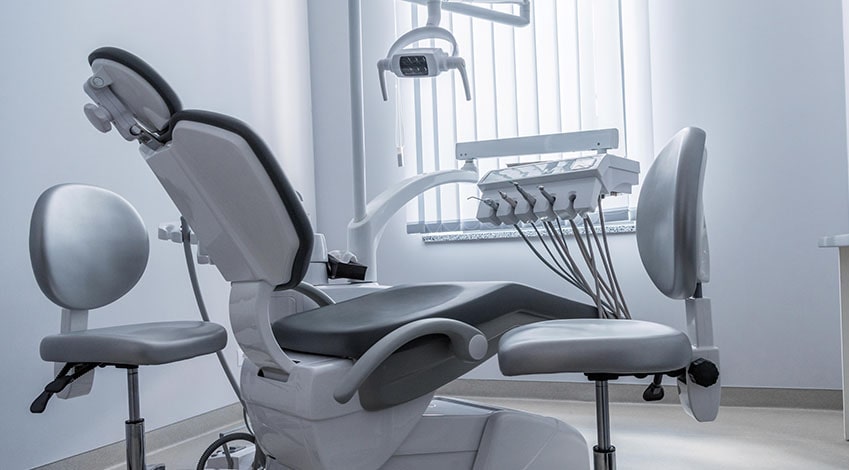At times, it has been vital to our health to keep our physical distance. In the worst situations, our healthcare professionals move to shut down all but emergency help to keep us, and themselves, safe.
That’s why, when dentists are open for visits, practicing dentistry safely is vital. Physical distancing is not possible, and we all know that viruses can spread easily from mouths and noses.
When you visit the dentist, here are some of the safety measures you can expect:
- Your visit will start when you book your appointment
Patient safety now starts before you get to the dental office. It includes everything that happens from the time you call for your appointment, to the time you arrive in your office, to when you go home again. You will have a pre-planning discussion to determine when and if you need to come to the office. - You’ll need to wait outside
Yes, it was nice to flip through the magazines, but now waiting for your turn at the dentist will usually mean waiting outside. If you can go in, chairs will be spaced in the waiting rooms and the doors will stay locked until it’s time for you to come in. Appointment times will be staggered to allow for deep cleaning and the removal of airborne contaminants. - Your dental office will look different
Dental offices have needed to rethink how staff and patients flow through the office. Some offices will no longer have a front desk attendant, to eliminate person-to-person contact for employees and patients. Most offices will require you to have your temperature taken before you meet with your dental professional. - Your hygienist or dentist will be masked
It is likely that your dental care professional will wear more than a traditional disposable face mask. Special anti-viral masks that are custom-fitted will be worn, and here’s the good news: many will be sustainable, so nothing goes in the garbage. You can imagine that if your dentist sees you for a five-minute visit, it isn’t reasonable that their mask is going in the trash afterward. Many will choose masks that use copper and silver yarn fabric, which have known antiviral properties. They will be reusable and washable, and provide comfort and practicality for your dental professional. - Your procedure may not be “in person”
Many dentists now do pre-screenings on the phone and will be seeing fewer people in person. Tele-dentistry and digital technology (which may include a virtual assistant) will become the norm.
No matter how it evolves, routine dental care is critical to maintaining good oral health, and the cost of trips to the dentist can add up quickly. For many people, this is the biggest challenge to taking care of their teeth.
There is a well-established link between poor oral health and poor overall health. The affordability of dental care is a serious concern that must be addressed, but there is more than just regular cleanings and treatment to consider — there’s the whole picture of oral health to keep in mind.
High dental care costs keep as many as six million Canadians from visiting the dentist every year. One way to maintain a healthy and happy smile is to purchase dental insurance to help offset the high cost of treatment.
There are four major types of dental services and dental coverage available to help you take care of your oral health.
- Basic Dental Coverage
These are standard treatments necessary to maintain good oral health, such as cleanings, exams, X-rays, and fillings. - Comprehensive Coverage
Comprehensive treatments are more extensive than the basic services and include root canals, periodontal treatments, and denture maintenance. - Major Dental Coverage
The most comprehensive dental treatment available, these services include dentures, crowns, and bridges. There is usually a waiting period before you can receive coverage for these types of services. - Orthodontic Coverage
Orthodontic treatments are used to align a person’s teeth, such as braces. Most patients receiving orthodontic services are adolescents, but you can receive this type of treatment at any age. These services are typically available in your third year of dental insurance coverage.
When determining how much and what type of coverage you need, it’s important to not only consider the types of treatment you have received in the past, but also the types of treatment you might need in the future. Even if you’ve never had a root canal or a bridge, that doesn’t mean you won’t need one several years from now.
In general, the more services a plan covers, the more expensive it is. So you may be tempted to choose a less expensive plan to save money. However, if you need more extensive dental treatment in the future, a plan that offers more comprehensive coverage could end up saving you money in the long run.
Don’t wait until you need a particular treatment to try to purchase coverage. If you do, you may be subjected to waiting periods or you may not qualify for coverage at all. Purchase coverage now to protect yourself financially, now and in the future.
Dental insurance plans are available with varying levels of coverage. It’s important that you understand the coverage you’ll receive before purchasing a plan. If you’re unsure what plan to choose, a knowledgeable SBIS insurance professional can help you assess your needs. They will explain the different coverage options available and answer your questions.
Contact us today to discuss your dental insurance needs and request a no-obligation quote to help you make an informed decision about your coverage.




